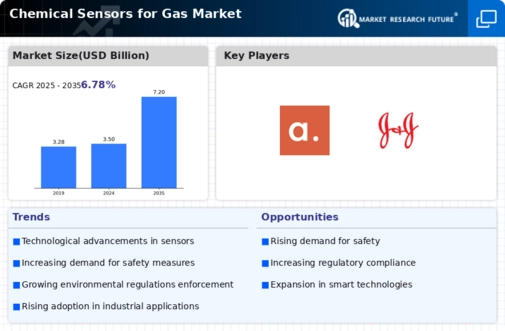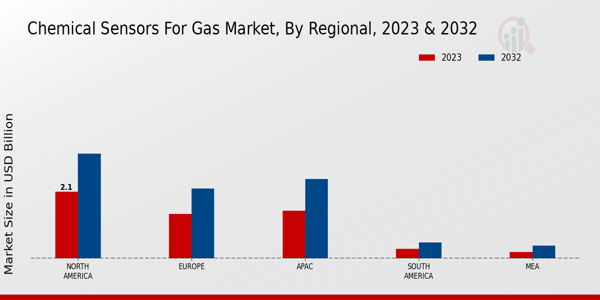Expansion of Smart Cities
The expansion of smart cities is contributing to the growth of the Global Chemical Sensors for Gas Market Industry. As urban areas integrate advanced technologies to improve infrastructure and public safety, the demand for gas sensors is increasing. These sensors play a vital role in monitoring air quality and detecting hazardous gases in urban environments. Governments are investing in smart city initiatives, which include the deployment of chemical sensors for real-time data collection and analysis. This trend is expected to support the market's growth trajectory, with projections indicating a rise to 7.2 USD Billion by 2035.
Market Growth Projections
The Global Chemical Sensors for Gas Market Industry is projected to experience substantial growth over the coming years. With an anticipated market value of 3.5 USD Billion in 2024, the industry is set to expand significantly, reaching an estimated 7.2 USD Billion by 2035. This growth reflects a compound annual growth rate of 6.78% from 2025 to 2035, driven by factors such as increasing environmental regulations, rising industrial applications, and technological advancements. The market's trajectory suggests a robust demand for chemical sensors, underscoring their critical role in various sectors.
Technological Advancements
Technological advancements are significantly influencing the Global Chemical Sensors for Gas Market Industry. Innovations in sensor technology, such as the development of miniaturized sensors and wireless communication capabilities, enhance the efficiency and accuracy of gas detection. These advancements allow for real-time monitoring and data analysis, which are critical in sectors like environmental monitoring and industrial safety. As technology continues to evolve, it is anticipated that the market will experience a compound annual growth rate of 6.78% from 2025 to 2035, indicating a robust future for chemical sensors.
Rising Industrial Applications
The Global Chemical Sensors for Gas Market Industry is witnessing a surge in demand driven by diverse industrial applications. Industries such as oil and gas, chemicals, and food processing require precise gas detection to ensure safety and operational efficiency. For example, in the oil and gas sector, sensors are crucial for detecting hazardous gases, thereby preventing accidents and ensuring worker safety. This trend is likely to contribute to the market's growth, with projections indicating an increase to 7.2 USD Billion by 2035, highlighting the expanding role of chemical sensors in various industrial settings.
Increasing Environmental Regulations
The Global Chemical Sensors for Gas Market Industry is experiencing growth due to stringent environmental regulations aimed at reducing air pollution. Governments worldwide are implementing laws that require industries to monitor and control emissions. For instance, the European Union's directives mandate the use of gas sensors in various sectors, including manufacturing and energy. This regulatory push is expected to drive the market, as companies invest in chemical sensors to ensure compliance. The market is projected to reach 3.5 USD Billion in 2024, reflecting the increasing demand for reliable monitoring solutions.
Growing Awareness of Workplace Safety
The Global Chemical Sensors for Gas Market Industry is also benefiting from an increased awareness of workplace safety. Organizations are prioritizing employee health and safety, leading to a higher demand for gas detection systems. Industries such as manufacturing and construction are investing in chemical sensors to mitigate risks associated with toxic gas exposure. This trend is likely to drive market growth, as companies recognize the importance of maintaining a safe working environment. The projected growth to 3.5 USD Billion in 2024 underscores the critical role of chemical sensors in enhancing workplace safety.













Leave a Comment